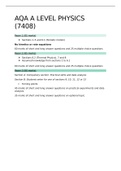AQA A LEVEL PHYSICS
(7408)
Paper 1 (85 marks)
Sections 1–5 and 6.1 (Periodic motion)
No kinetics or rate equations
60 marks of short and long answer questions and 25 multiple choice questions
Paper 2 (85 marks)
Sections 6.2 (Thermal Physics), 7 and 8
Assumed knowledge from sections 1 to 6.1
60 marks of short and long answer questions and 25 multiple choice questions
Paper 3 (80 marks)
Section A: Compulsory section: Practical skills and data analysis
Section B: Students enter for one of sections 9, 10, 11, 12 or 13
Turning points
45 marks of short and long answer questions on practical experiments and data
analysis.
35 marks of short and long answer questions on optional topic.
,Measurements and their errors
Use of SI units and their prefixes
Fundamental (SI base) units – Systéme International (system of
measurement)
o Mass (m, kg), length(l, m), time(t,s)
o Amount of substance (n, mol), temperature (T/theta, K)
o Electric current (I, A)
SI Prefixes: T(1012) , G(109), M(106) , k(103), c(10-2), m(10-3), μ(10-6), n(10-9),
p(10-12), f(10-15)
Converting eV -> J (1eV=1.6x10-19J), kW h etc.
Limitation of physical measurements
Random and systematic errors.
Precision, repeatability, reproducibility, resolution and accuracy.
Uncertainty: Absolute, fractional and percentage uncertainties represent
uncertainty in the final answer for a quantity.
Combination of absolute and percentage uncertainties.
Represent uncertainty in a data point on a graph using error bars.
Determine the uncertainties in the gradient and intercept of a straight-line
graph.
Individual points on the graph may or may not have associated error bars.
Estimation of physical quantities
Orders of magnitude.
Estimation of approximate values of physical quantities.
Particles and radiation
Particles
Constituents of the atom
Simple model of the atom, including the proton, neutron and electron.
o Proton +1e, 1
o Neutron 0, 1
o Electron -1e, 1
The atomic mass unit (amu) is included in the A-level Nuclear physics
section.
Specific charge of the proton and the electron, and of nuclei and ions.
o Specific charge= charge/mass – we can assume mass of e - to be
negligible unless otherwise stated
o Specific charge of an atom = 0 as its neutral!
Proton number - Z, nucleon number – A
Meaning of isotopes and the use of isotopic data
Stable and unstable nuclei
The strong nuclear force; its role in keeping the nucleus stable
o Short-range attraction up to approximately 3 fm
Beyond 3fm it is negligible as strength falls quickly beyond
range.
, o Very-short range repulsion closer than approximately 0.5 fm
o >3fm – negligible, 0.5-3fm - attractive, <0.5fm - repulsive
o Works equally between nucleons
Stable nuclei; atoms with more neutrons than protons tend to be more
stable as it adds additional strong force balancing out forces of repulsion.
Unstable nuclei; alpha and beta decay
o Alpha decay – emit helium nucleus
o Beta minus decay – n->p + antielectron neutrino
o Beta plus decay – p->n + electron neutrino
The existence of the neutrino was hypothesised to account for
conservation of energy in beta decay.
Particles, antiparticles and photons
For every type of particle, there is a corresponding antiparticle.
o Electron – positron
o Proton – antiproton
o Neutron – antineutron
o Neutrino - antineutrino
Comparison of particle and antiparticle masses, charge and rest energy in
MeV.
o All on data sheet!
Photon model of electromagnetic radiation, the Planck constant.
o E = hf = hc/ lambda
o Packets of energy is emitted whenever a charged particle loses
energy when it slows, stops and changes direction.
o Power=nhf (laser beam)
Knowledge of annihilation and pair production and the energies involved.
o Annihilation – particle & antiparticle collide to produce high energy
gamma photons (2 gammas emitted in opposite directions in order
to conserve momentum)
o Pair production – gamma photon with sufficient energy interacts
with a nucleus producing the pair.
Particle interactions
Four fundamental interactions: gravity, electromagnetic, weak & strong
nuclear.
o Exchange particles to explain forces between elementary particles
E.g. EM repulsion between protons is due to the exchange of
virtual photons that exist for only a very short time.
Momentum is transferred from the photons as they are
absorbed by a proton.
o Weak – W+/W-
o Strong – pi+/pi0/pi- (hadrons only)
o EM – virtual photon
o Knowledge of the gluon, Z0 and graviton will not be tested.
Weak interaction limited to β− and β+ decay, electron capture & e–p
collisions
o E capture – inner electron drawn to nucleus where it interacts and
combines with a proton forming a neutron and a neutrino is ejected.
Unstable -> stable nuclei




